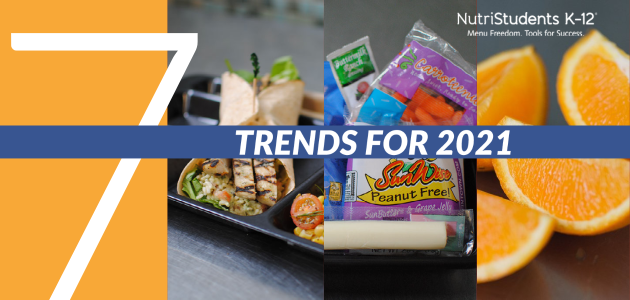
There’s no doubt COVID-19 has reshaped child nutrition programs for the foreseeable future. Since March 2020, foodservice directors have had to adapt nearly every aspect of their programs on the fly to respond to changing guidance at the federal, state and district level. While we’re hopeful the country may see some sense of normalcy by fall 2021, there are several trends from the COVID-19 era that will shape school nutrition programs – from the menus to procurement to service – in 2021 and beyond.
To reduce the possibility of contamination, districts have moved to prepackaged meals – sometimes relying on pre-packaged, single-serve items, such as bags of mini carrots and sliced apples, and seed-butter sandwiches, to comprise a weekly meal bundle, or preparing and assembling meals in take-out packaging. Some foodservice directors have invested in vacuum sealers to prepare and freeze meals in advance. This gives them more options for meals and minimizes waste when compared to traditional to-go packaging. When operations return to normal, could we see vacuum sealers used to preserve leftovers for service at a later date?
Rather than providing five defined breakfasts and five defined lunches, many districts will provide grocery meal kits. With ingredients like a pound of hamburger, spaghetti, pasta sauce, fruit and a half gallon of milk, families can prepare the batch-cook recipe included in their weekly meal kits. The menus meet the nutritional requirements of the Summer Food Service Program and help foodservice staff save packing time, simplify procurement, incorporate commodity foods and minimize waste vs. single-serve, prepackaged foods. Under current USDA waivers, grocery menus can be used whenever students are away from school for multiple days. NutriStudents K-12 is currently offering any foodservice program in the country 5 free weeks of grocery menus for downloading.
While efforts like buying local and farm to school aren’t new, the pandemic has given rise to their importance. Districts will continue to partner with local businesses to help them survive the effects of the pandemic while helping to keep their neighbors employed during these trying times and beyond.
Immunity-boosting foods like citrus fruits and certain vegetables are popular as people seek to protect themselves and their families from the coronavirus (see the list available on page 29 of the NutriStudents K-12 COVID-19 Foodservice Guide). As people make healthier food choices, vegetable substitutes like cauliflower rice and crusts, and zucchini and squash noodles will also continue to gain traction, making their way onto districts’ school lunch menus. Meatless Mondays may have been sidelined with 5-day and 7-day meal packs for distance learners, but heat-and-serve meatless options like garden burgers, queso omelets and bean and cheese burritos are still in use. When students are back in the buildings, Meatless Mondays and plant-based entrees will surge in popularity.
With many school foodservice programs operating in the red, foodservice directors will get creative to stretch budgets, particularly if they lose staff due to budget cuts or attrition. More will discover the benefits of using foodservice software that can streamline operations and increase participation, such as NutriStudents K-12.
When school returns to normal, we expect students to be invited back into kitchens to help with the food preparation process, clean up and delivery of meals to classrooms. The culinary arts training program for high school students, ProStart, introduces students to careers in foodservice, sometimes starting in students’ own high schools.
Foodservice during the pandemic has disrupted districts’ normal use of commodity foods. With pallets of commodity foods in cold storage in spring 2020, foodservice directors adapted their menus to use those commodity foods for distance-learning meal packs. Quick-cook, scratch-made recipes, such as NutriStudents K-12 fiesta chicken wraps and pesto chicken pasta, which use commodity chicken and pasta or wraps, are designed to maximize commodity use while providing flexibility to serve hot or cold, in-school or provided in distance-learning meal packs.
The federal government’s COVID-19 emergency feeding programs have set the stage for a bigger push for universal free meals, which will gain steam post-pandemic under the new administration. Families have also become accustomed to receiving seven-day meal packs, which could lead to schools more proactively providing weekend meals.